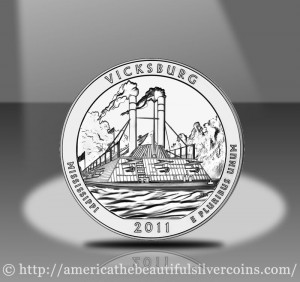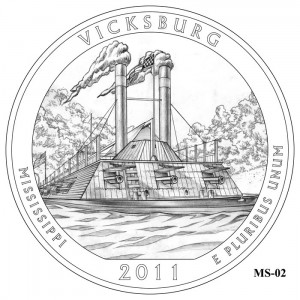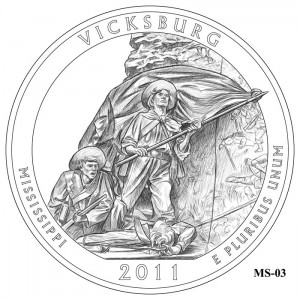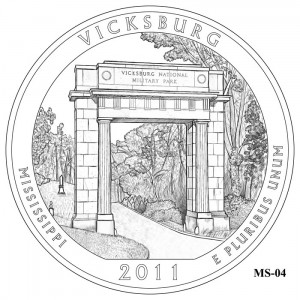The ninth strike to appear as part of the eleven year America the Beautiful Silver Bullion Coin™ Program from the United States Mint will be the 2011 Vicksburg America the Beautiful Silver Bullion Coin. Each coin in the series will consist of a hefty five ounces of .999 fine silver and a massive diameter of three inches.
Sales of the Vicksburg Silver Bullion Coin began by the US Mint on June 20, 2011. On that date, the strikes were made available for order by the Mint’s network of authorized purchasers. A mintage of 126,700 and waning demand for the series meant the strikes were available the rest of 2011 and into 2012.
The design of the coins under this program will replicate the designs found on the America the Beautiful Quarter Dollars. As such, the obverse will contain a portrait of the first President of the United States, George Washington. Slightly different from the quarter dollars, however, is an edge inscription to be found on the bullion coins stating their weight and purity.
Vicksburg National Military Park will be featured on the reverse of the coin by showcasing a portion of the park. The final design for the quarter (and thus this silver bullion coin) is described by the US Mint with:
"The Vicksburg National Military Park quarter reverse design depicts the U.S.S. Cairo on the Yazoo River as it would have been seen when it served the U.S. Navy during the Civil War. Inscriptions are VICKSBURG, MISSISSIPPI, 2011 and E PLURIBUS UNUM. The coin’s reverse was designed by AIP Master Designer Thomas Cleveland and sculpted by United States Mint Sculptor-Engraver Joseph Menna."
Design candidates for the strike were created and released by the US Mint for review. Among those who reviewed the designs were two bodies given the task of commenting on possible upcoming coinage of the United States, the Commission of Fine Arts and the Citizen’s Coinage Advisory Committee.
The design candidates for the Vicksburg coin are shown below as well as the selection and comments of the CFA and the CCAC.
The CCAC favored design number "MS-02" with these comments:
"For the coin portraying Vicksburg National Military Park in Mississippi, the Committee strongly favored design MS-02, which carries an image of the U.S.S. Cairo on the Mississippi River as it would have appeared during the Civil War," wrote the Citizen’s Coinage Advisory Committee in a letter to Treasury Secretary Timothy F. Geithner. "Members felt that this design, in addition to the quality of its composition, has the virtue of showcasing the historical significance of the Navy in the Civil War."
The CFA preferred "MS-04" but recommended some changes as well as commented on other designs.
"The Commission supported alternative #4, depicting the entrance arch of the park, while recommending development of a simplified design that emphasizes this iconic feature without the attempt to depict a realistic landscape setting," wrote the CFA in a letter to Mint Director Ed Moy. "The Commission members also discouraged the depiction of sculptural fragments of memorials, as seen in alternatives #1 and #3, commenting that such subjects are not easily recognizable in isolation as historic design features representing the park."
The America’s Beautiful National Parks Quarter Dollar Coin Act of 2008 dictates that the Treasury Secretary will make the final selection after he receives the recommendation of the Mint Director, the CFA, the CCAC as well as comments from the chief executive of each host location and the Secretary of the Interior.
Up to five new strikes will appear each year from 2010 through 2021 as part of each of the America the Beautiful Quarters and Silver Bullion programs. On each coin will be a design that represents a selected National Park or National Site in each state, the District of Columbia and U.S. territories — Puerto Rico, Guam, American Samoa, the U.S. Virgin Islands and the Northern Mariana Islands.
These silver bullion coins are not sold directly by the US Mint to the public, but instead to a select group of authorized buyers (coin dealers, precious metal providers, etc.) who then resell the coins.
The United States Mint will also be releasing a collector grade version of this coin known as the Vicksburg Silver Uncirculated Coin.
Vicksburg National Military Park in Mississippi
Commemorating not only the famous battle, but the entire campaign that led up to it as well as the attempted defense of the city is the Vicksburg National Military Park in Mississippi.
Vicksburg was considered one of the most strategic locations in all of the Confederate territory during the first years of the American Civil War. Located in the western theater of the war, continued control of Vicksburg not only prevented Union shipping on the Mississippi River, it also ensured a flow of information and much-needed agricultural supplies from the states west of the river.
"Vicksburg is the nail head that holds the South’s two halves together," President of the Confederate States of America Jefferson Davis was known to say.
Union forces had been attempting to gain control of Vicksburg for more than a year, mostly through an ineffective naval bombardment. With limited men, an invasion of the city was impossible and the bombardments were ceased.
Deciding the city was too important to remain in Southern control, Union Major General Ulysses S. Grant was put in charge of defeating the Confederate forces surrounding and in Vicksburg. To this end, maneuvers were started in December of 1862.
The first portion of the campaign historians have labeled "Operations Against Vicksburg" and were met with failure by Union forces. Grant then turned his sites on reaching Vicksburg through the swamplands. His "Bayou Operations" proved also to be a failure.
Finally, too stubborn to quit, Grant decided on a two-pronged approach using naval assistance and his massive army to besiege the city. Successful in several battles leading up to the outskirts of Vicksburg, Grant began to lay siege to the city. This process lasted for six weeks, then after 47 days and no food or supplies remaining, forces in Vicksburg surrendered on July 4, 1863.
One day after the Confederate defeat at Gettysburg, historians consider the Vicksburg and Gettysburg victories the turning point of the war for Union forces.
An estimated 700,000 annual visitors come to the Vicksburg National Military Park to follow the 16-mile tour road, see the 1,325 historic monuments and markers and ponder over the restored gunboat USS Cairo




